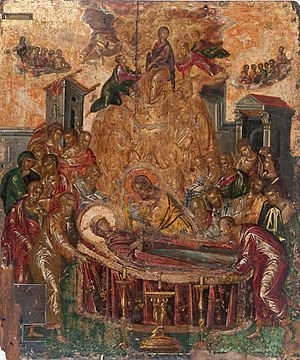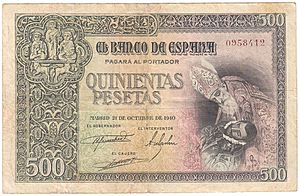The Burial of the Count of Orgaz facts for kids
Quick facts for kids The Burial of the Count of Orgaz |
|
|---|---|
| Spanish: El Entierro del Conde de Orgaz | |
 |
|
| Artist | El Greco |
| Year | 1586 |
| Medium | Oil on canvas |
| Dimensions | 480 cm × 360 cm (190 in × 140 in) |
| Location | Iglesia de Santo Tomé, Toledo |
The Burial of the Count of Orgaz (Spanish: El Entierro del Conde de Orgaz) is a famous painting from 1586 by El Greco. He was a very important Renaissance painter, sculptor, and architect who came from Greece. Many people think this is one of his best works.
The painting tells a popular local story from El Greco's time. It's a very large painting, split into two main parts: a heavenly part at the top and an earthly part at the bottom. Even though it's divided, the two parts blend together well, making it feel like one complete scene. Art experts have called it a masterpiece of Western art and a perfect example of El Greco's unique style.
Contents
The Painting's Story
The idea for this painting comes from a legend that is hundreds of years old. Around the year 1323, a kind man named Don Gonzalo Ruiz de Toledo died. He was the mayor of a town called Orgaz. Later, his family received the title of Count, which is why he is known as the Count of Orgaz.
The Count of Orgaz was a very religious and generous person. He gave money to help make the church of Santo Tomé bigger and more beautiful. This was El Greco's local church, and the Count wanted to be buried there.
A Heavenly Miracle
The legend says that when the Count was being buried, two important saints, Saint Stephen and Saint Augustine, came down from heaven themselves. They buried him with their own hands! Everyone watching was amazed.
El Greco painted this exact moment. The church even gave him a contract that described every detail he needed to include. The miracle is also written on a special stone plaque on the wall below the painting.
Modern Touches in an Old Story
Even though El Greco followed the contract, he added some modern touches. For example, he painted the funeral procession to look like a 16th-century event. He also showed the saints wearing clothes from his time.
Most importantly, El Greco included portraits of important people from Toledo who were alive during his time. This "modernized" the old legend. It also helped teach people about the importance of respecting saints and doing good deeds. This was a key idea during the Counter-Reformation, a time when the Catholic Church was trying to renew itself.
How the Painting Was Made
The painting was ordered by Andrés Núñez, who was the parish priest of the Santo Tomé church. He wanted to make the Count's burial chapel look better, and this painting was the final step in his plan to honor the church.
El Greco signed the contract on March 18, 1586. The contract said what the painting should show and that El Greco would pay for the materials. It also said the painting should be finished by Christmas 1587. El Greco worked very fast and finished the painting between late 1587 and spring 1588.
Payment and Popularity
After the painting was done, there was a long discussion between the priests and El Greco about how much he should be paid. The contract said the price would be decided by experts. El Greco eventually agreed to a lower price of 13,200 reales.
By 1588, many people were already coming to Santo Tomé just to see the painting. It was very popular because it showed real, important people from Toledo. It was a tradition for famous and noble men of the town to attend the burials of other noble people, and the contract even said this should be shown in the painting.
El Greco honored the important people of Toledo—like the clergy, lawyers, poets, and scholars—by painting them into this famous artwork. The Burial of the Count of Orgaz is admired not just for its art, but also because it's like a gallery of portraits of some of the most important people in Toledo at that time. In 1612, a writer named Francisco de Pisa said that people in Toledo "never grow tired" of looking at it because it shows "realistic portraits of many notable men of our times."
Artistic Influences

Some art experts believe the way the painting is put together is similar to old Byzantine art, especially paintings of the "Dormition of the Mother of God." This idea came up after a painting by El Greco called Dormition was found in 1983.
However, other experts think the painting is more like Italian Renaissance art. They point to artists like Tintoretto and Titian. For example, the way the two saints are grouped around the dead body is similar to Titian's early Entombment.
Some also suggest that the painting was influenced by Spanish funeral art of the time. It seems El Greco combined many different ideas and styles to create his unique masterpiece.
Why This Painting is Special
No matter what influences it had, The Burial of the Count of Orgaz is seen by everyone as a masterpiece. It's considered El Greco's first truly personal work and the peak of his first ten years of painting in Toledo. It marked the beginning of his mature style, where his art became more spiritual and less focused on physical details.
The painting shows El Greco's amazing skill as a portrait artist. He captured the faces and expressions of the important people of Toledo perfectly. His use of rich, bright colors also shows he was a talented colorist. Even the tiny scenes on the saints' clothes show his skill as a miniaturist.
The way El Greco combined real people with a miraculous event, and how he made the painting feel deep without using traditional space, shows how extraordinary his art was. As Francisco de Pisa said, there are "always new things to contemplate in it," making it a constant source of learning and enjoyment.
Even famous scientist Albert Einstein saw the painting and called it "a magnificent painting" and "among the profoundest images I have ever seen."

See also
 In Spanish: El entierro del conde de Orgaz para niños
In Spanish: El entierro del conde de Orgaz para niños
- List of works by El Greco
- 100 Great Paintings, 1980 BBC series



